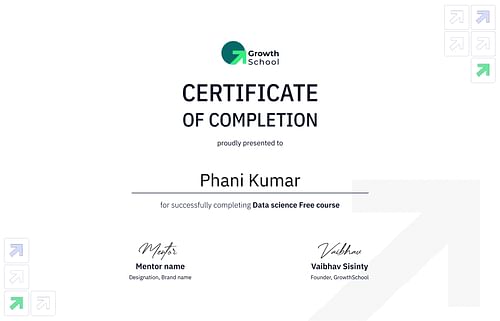Free Product Strategy Course on Creating a Data-Informed Product Strategy
Learn how to develop a powerful data-informed product strategy with our free product strategy course. Gain the skills to drive success in your business. Sign up now!
Read More
Before you ask, we do give certificates!
Get certified upon course completion and supercharge your career journey.

Learning Objectives
1. Guidance on LinkedIn Post Creation
Tips provided on creating a LinkedIn post about the webinar, including mentioning the mentor, using specific hashtags, and encouraging engagement.
2. Importance of Identifying Target Audience
Session covered the significance of identifying the target audience in product strategy separate from product development, focusing on ideation, planning, and roadmap definition.
3. Analyzing Online Purchases Trends
Presentation focused on analyzing trends in online purchases over six months, highlighting considerations such as existing offerings, competition, average ticket size, internet penetration, and paying capacity.
4. Avoiding Assumptions in Product Management
Importance of avoiding assumptions and confirmation bias in product management emphasized, stressing the need for open-minded data analysis to understand perspectives and not solely rely on confirming data.
Read More
Who's it for
Product Managers
Marketing Professionals
Entrepreneurs
User Experience Designers
Business Analysts
Our Learners love GrowthSchool
What will I learn
Chapter 1
Presentation Guidelines and Setup
In this chapter, the moderator provides feedback on presentation setup and reminds the presenter of guidelines to follow during the session, such as avoiding specific greetings and not mentioning the number of participants. The presenter is instructed to follow a specific flow after the thank you slide.
Chapter 2
Creating a LinkedIn Post
The session offers guidance on creating a LinkedIn post about the webinar, mentioning the mentor and using specific hashtags. The moderator suggests content ideas, emphasizes the benefits of participating, and encourages engagement. Participants are given a form in the chat to submit their posts.
Chapter 3
Identifying Target Audience in Product Strategy
This segment covers the importance of identifying the target audience in product strategy. It distinguishes product development from product strategy, focusing on ideation and planning. The discussion also touches upon defining a roadmap and its key components.
Chapter 4
Analyzing Online Purchases Trends
The presentation focuses on analyzing online purchase trends over the next six months. Factors like restaurant offerings, competition from food delivery companies, and average ticket size are highlighted. The speaker stresses the importance of internet penetration and paying capacity in determining the total addressable market for online food purchases.
Chapter 5
Avoiding Assumptions and Confirmation Bias
The transcript discusses the importance of avoiding assumptions and confirmation bias in product management. It emphasizes the need to understand perspectives and not solely rely on data that confirms preconceived notions. Examples of confirmation bias in product management are shared, underlining the need to approach data analysis with an open mind.
Chapter 6
Being Data Informed vs. Data Driven
This chapter differentiates between being data informed and data driven. It explains the implications of blindly believing data versus using data as one tool among many. An example highlights the decision-making process between two features based on numerical data or considering various other factors.
Chapter 7
Enhancing Search Experience
The discussion centers on a new search feature allowing users to search by name. Issues of page breaks and query timeouts for large numbers of friends are raised, emphasizing the importance of data integrity. Data points for search experience data collection are suggested to improve the search experience.
Chapter 8
Importance of Technology Understanding for Product Managers
The speaker underscores the importance of product managers having a basic understanding of technology, drawing from personal experience in various companies. The audience feedback demonstrates that the session was informative, concluding with farewells and well wishes to all participants.
Meet your Mentor
Pratishtha Agarwal
Sr. Product Manager @ PayPal
Pratishtha Agarwal is a skilled Sr. Product Manager at PayPal, based in Bengaluru, India. With diverse experience in building products and digital solutions for various industries, including MSMEs, Tata Steel, Tata Sons, Tata Consumer Products, and TCS ADD, she excels in product management, digital strategy, and fostering digital transformation.
Frequently Asked Questions
What are the main pillars of Product Strategy?
The main pillars of Product Strategy include market analysis, customer research, competitor analysis, and product roadmap planning.
What is Product Strategy, and why is it important to learn about?
Product Strategy defines the direction of a product to meet market needs, making it crucial for product success.
Is this Product Strategy course designed for corporate training and workforce upskilling?
Yes, this Product Strategy course is tailored for corporate training and enhancing employees' skills in product strategy.
How long can I access the free product strategy course content?
You can access the free product strategy course content for an unlimited period after enrolling in the course.
Will I receive a certification upon completion of the free product strategy course course?
Yes, upon successful completion of the free course, you will receive a certification to showcase your knowledge.

How to create a strong Data informed Product Strategy
3.5
(262 ratings)
Intermediate
13 May 2025 at 5:30 pm GMT
19k Learners enrolled
Mentor
Pratishtha Agarwal
Sr. Product Manager @ PayPal
Why GrowthSchool?
GrowthSchool is where you become the Top 1% in your field. We bring the best of Product, Growth, Design, Tech, data and business mentors from brands like Google, Meta, Uber etc doing the jobs you want to do tomorrow.
400k+
Total Students
Top Startup India 2024
Backed by the best
and 80+ Angel investors like



What are Free Courses?
Free online courses offer a wealth of knowledge in product, design, growth, and marketing without cost. They provide flexibility for skill enhancement and professional development. Many courses include certificates, bolstering resumes and LinkedIn profiles, demonstrating a commitment to learning and advancement in these dynamic fields.




